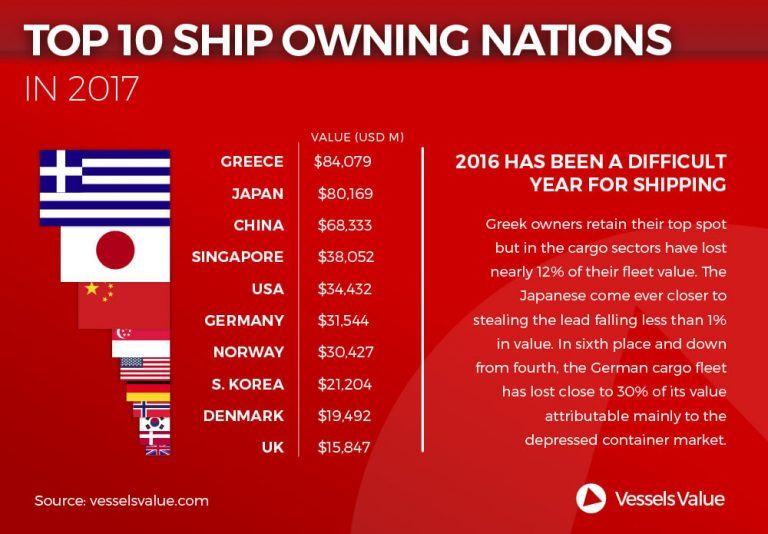- Joined
- Dec 7, 2017
- Messages
- 2,968
- Reaction score
- 0
From 1812, or arguably earlier, to 1944 the World Order was maintained by British Sea Power.

After WW2 the UK's role reduced and that baton was handed to its eldest child the USA.

Ruling the waves with your navy and linking colonies with homelands and production fields with markets with your merchant fleet is how the world economy is organised. Who rules the waves decides who buys and sells what, where, when and at what price and who can project political and military power beyond their borders.
The shipbuilding industry, as well as the manufacturing of the various heavy equipment, machine tools and precision instruments required to operate docks and ships etc. has shifted from the UK and USA to the Far East.
World Top 10 Shipbuilding Countries
1. Hyundai Heavy Industry – Ulsan, South Korea
2. Daewoo Shipbuilding – Okpo, South Korea
3. Samsung Heavy Industry – Geoje, South Korea
4. Hyundai Samho – Samho, South Korea
5. Mitsubishi Heavy Industry – Nagasaki, Japan
6. Tsuneishi shipbuilding – Numakuma, Japan
7. Oshima Shipbuilding – Oshima, Japan
8. Hyundai Mipo – Ulsan, South Korea
9. Imabari Shipbuilding – Marugame, Japan
10. Shanghai Waigaoqiao – Shanghai, China
100% East Asian
World Top 10 Biggest Ports
1 Shanghai, China,
2 Singapore
3 Tianjin, China
4 Guangzhou, China
5 Ningbo, China
6 Rotterdam, Netherlands
7 Suzhou, China
8 Quingdao, China
9 Dalian, China
10 Busan, South Korea
90% East Asian
East Asian countries are rapidly moving to a global domination of vessel ownership.

Now China is embarking on a huge naval shipbuilding program
Significantly, just since 2014, China has launched naval vessels with a total tonnage greater than the tonnages of the entire French, German, Indian, Italian, South Korean, Spanish or Taiwanese navies (see graphic). However, Japan’s large number of destroyers and the UK’s big Royal Fleet Auxiliary vessels just push those two countries’ respective tonnage totals ahead of the Chinese output for 2014–18.

The data also underscores how that Chinese output has accelerated in recent years, and throws up some striking comparisons even with recent US naval shipbuilding. In the period 2012–14, US output remained just ahead in total tonnage terms, not least with the launch of the 100,000-tonne aircraft carrier USS Gerald R. Ford. In 2015–17, China was significantly ahead, thanks in part to the launch of its own first indigenous aircraft carrier.

/
it may not be too long before, as well as assembling an impressive armada in the South China Sea, China’s investments in naval capability will see it able to deploy really quite significant task groups of ships further afield as well.
Edit: all of my URL links did not show up.

After WW2 the UK's role reduced and that baton was handed to its eldest child the USA.

Ruling the waves with your navy and linking colonies with homelands and production fields with markets with your merchant fleet is how the world economy is organised. Who rules the waves decides who buys and sells what, where, when and at what price and who can project political and military power beyond their borders.
The shipbuilding industry, as well as the manufacturing of the various heavy equipment, machine tools and precision instruments required to operate docks and ships etc. has shifted from the UK and USA to the Far East.
World Top 10 Shipbuilding Countries
1. Hyundai Heavy Industry – Ulsan, South Korea
2. Daewoo Shipbuilding – Okpo, South Korea
3. Samsung Heavy Industry – Geoje, South Korea
4. Hyundai Samho – Samho, South Korea
5. Mitsubishi Heavy Industry – Nagasaki, Japan
6. Tsuneishi shipbuilding – Numakuma, Japan
7. Oshima Shipbuilding – Oshima, Japan
8. Hyundai Mipo – Ulsan, South Korea
9. Imabari Shipbuilding – Marugame, Japan
10. Shanghai Waigaoqiao – Shanghai, China
100% East Asian
World Top 10 Biggest Ports
1 Shanghai, China,
2 Singapore
3 Tianjin, China
4 Guangzhou, China
5 Ningbo, China
6 Rotterdam, Netherlands
7 Suzhou, China
8 Quingdao, China
9 Dalian, China
10 Busan, South Korea
90% East Asian
East Asian countries are rapidly moving to a global domination of vessel ownership.

Now China is embarking on a huge naval shipbuilding program
Significantly, just since 2014, China has launched naval vessels with a total tonnage greater than the tonnages of the entire French, German, Indian, Italian, South Korean, Spanish or Taiwanese navies (see graphic). However, Japan’s large number of destroyers and the UK’s big Royal Fleet Auxiliary vessels just push those two countries’ respective tonnage totals ahead of the Chinese output for 2014–18.

The data also underscores how that Chinese output has accelerated in recent years, and throws up some striking comparisons even with recent US naval shipbuilding. In the period 2012–14, US output remained just ahead in total tonnage terms, not least with the launch of the 100,000-tonne aircraft carrier USS Gerald R. Ford. In 2015–17, China was significantly ahead, thanks in part to the launch of its own first indigenous aircraft carrier.

/
it may not be too long before, as well as assembling an impressive armada in the South China Sea, China’s investments in naval capability will see it able to deploy really quite significant task groups of ships further afield as well.
Edit: all of my URL links did not show up.
Last edited:

